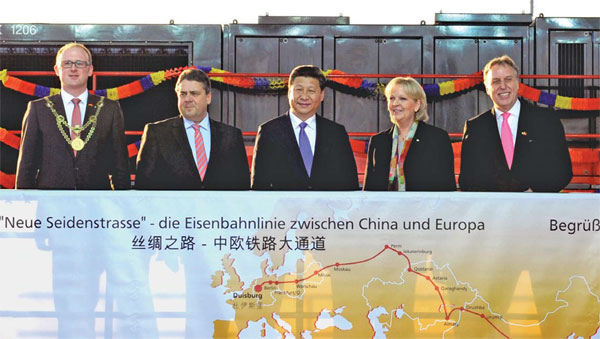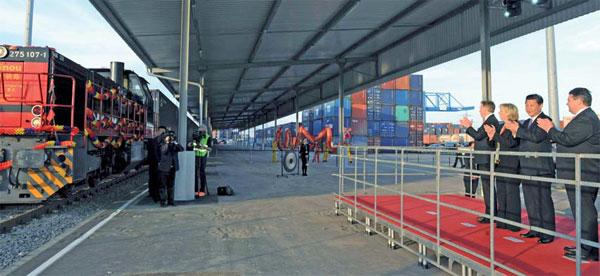Link across continents to gather steam
Updated: 2014-06-06 08:14
By Tuo Yannan (China Daily Europe)
|
|||||||||||
|
Chinese President Xi Jinping visits Port of Duisburg in Germany on March 29. Photos by Rao Aimin / Xinhua |
|
Xi views the arrival of a train that travelled from Southwest China's Chongqing municipality, in Duisburg. |
More and more Chinese and European businesses are beginning to cash in on the speed and the economy of the rail link between Chongqing and Duisburg
When the train from Chongqing, Southwest China, rolls into Duisburg, western Germany, every Monday and Thursday, you can be sure that one of those standing on the platform like an anxious parent waiting for a child's homecoming will be Ronald Kleijwegt.
But something strange happened recently. Instead of being on the platform waiting for the train, as he has dozens of times over the past three years, Kleijwegt was there bidding the train farewell as it pulled out on its 16-day return journey to China.
On May 23, for the first time since the Chongqing-Duisburg line opened three years ago, the train was carrying goods to China, in this case Ford automotive parts. Shipments on the line had previously been a strictly one-way affair, with the trains of more than 700 meters in length long delivering goods to Duisburg, then returning to Chongqing empty.
Kleijwegt's platform duties are part of his job as director of logistics for Europe, Middle East and Africa for the IT company Hewlett-Packard, and the consignments the train carries include computers and printers.
On their journey, trains on the Chongqing-Xinjiang-Europe International Railway travel through Xi'an, Lanzhou, Urumqi and the Alataw Pass, where they enter Kazakhstan, before crossing Russia, Belarus and Poland and entering Germany. That 11,179-kilometer trip has been made more than 100 times over the past three years, says Yang Liqiong, vice-director of the Chongqing Municipal Economy and Information Commission and administrative vice-director of the Chongqing Logistics Council.
The 16-day trip compared with the minimum 50 days needed to transport goods by sea from China's eastern ports. Given the short shelf life of IT products, that makes rail particularly attractive for getting goods to market in Europe.
"HP has used the railway to carry more than 3,400 containers of IT products made in Chongqing on 80 trains since 2011," Kleijwegt says.
While there is little difference in the cost of rail freight and sea freight, rail makes it possible to cut door-to-door service from 39 days to 20 days, he says.
"That kind of saving on delivery time means a lot to an international company."
The cost is one-fifth that of transporting cargo by air, Yang says, and there is only one customs inspection along the route.
"Our pilot train began operating in 2011, and in that time the cost has fallen from 80 cents for 22 metric tons each kilometer to 70 cents."
The first train carried only HP products including laptops, tablet PCs and printers. Many businesses across Asia and Europe have now joined HP in taking advantage of the link. Apart from electronics and car parts, goods carried include cars, motorcycles and daily commodities, Yang says.
"About 80 percent of China's exports by railway to Europe now get there on the Chongqing-Duisburg line."
The two trains a week will be supplemented by another one beginning this month. This year, 102 trips are scheduled from Chongqing to Duisburg, and 12 are scheduled from Duisburg to Chongqing, and eventually that will stretch to daily departures, Yang says.
As transport times and costs are reduced, rail links between Central and Western China and Central and Eastern Europe are propelling trade between the regions.
Kleijwegt says: "Chongqing is one of China's most important inland cities for production, given that sea transport is super slow. Rail is a good alternative."
She Weihua, commercial counselor of the consulate general of China in Frankfurt, said in 2012 that China's trade with North Rhine-Westphalia, Germany's most populous state, and where Duisburg is located, accounted for about a quarter of the trade between China and Germany.
China's economic trade with the countries along the New Silk Road reached $549.5 billion in 2012, She said, adding that the railway would be an important fillip to economies along the line.
Dong Jianguo, deputy secretary general of Chongqing Municipal Government, says Chongqing has enjoyed economic growth of 15 percent in recent years, and external trade has increased seven fold over the last five years.
"Since 2011, the Chongqing-Duisburg line has enriched the ocean-dominated logistics system between China and Europe, ushering in a new era of China-EU collaboration."
Although business on the railway line is rapidly gathering pace, challenges remain. One of those is the fact that at the moment the flow of goods is heavily lopsided in one direction, and a certain degree of equilibrium needs to be attained to ensure operations remain profitable.
Chongqing has begun to tackle this problem by promoting the line in Europe. Last month, it set up three new Chongqing Municipal Government Logistics Europe Liaison offices, located in Antwerp, Duesseldorf and Rotterdam.
Dong says the opening of the liaison office in Antwerp heralded the beginning of a new phase for the Chongqing-Xinjiang-Europe International Railway.
The government of Chongqing is keen for European companies to take advantage of the opportunity in boosting trade and logistics exchanges, he says.
Uwe Korkman, director of the Duesseldorf City Economic Promotion Bureau, says the liaison office there is counting on the rail link to strengthen ties and promote China-EU trade.
Ludwig Caluwe, vice-governor of Antwerp province, says: "I believe Chongqing's importance in China, and internationally, can only grow. The New Silk Road can play a major role in producing this growth."
Every day 250 freight trains depart Antwerp to about 70 different destinations in 19 countries, Caluwe says.
"With the commercialization of the New Silk Road, this number will only increase. Many exporters in Antwerp have expressed interest in changing the way they export their goods to Chongqing, Russia or Kazakhstan. I'm convinced that close cooperation between Chongqing and Antwerp will result in an economically viable business model for the rail link."
The Europe liaison offices of Chongqing Logistics will build cargo centers in Belgium, the Netherlands, Hungary, Poland, Russia and other countries in the near future, the Chongqing government says.
tuoyannan@chinadaily.com.cn
(China Daily European Weekly 06/06/2014 page21)
Today's Top News
China finds way to play in 2014 World Cup
Protocol targets sex violence
Premier all business on Europe trip
Poland-China train on maiden trip
Iraq facing 'mortal threat' from militants
China, Italy boost ties
Brazil averts strike before WCup
Red meat 'linked to cancer'
Hot Topics
Lunar probe , China growth forecasts, Emission rules get tougher, China seen through 'colored lens', International board,
Editor's Picks

|

|

|

|

|

|







